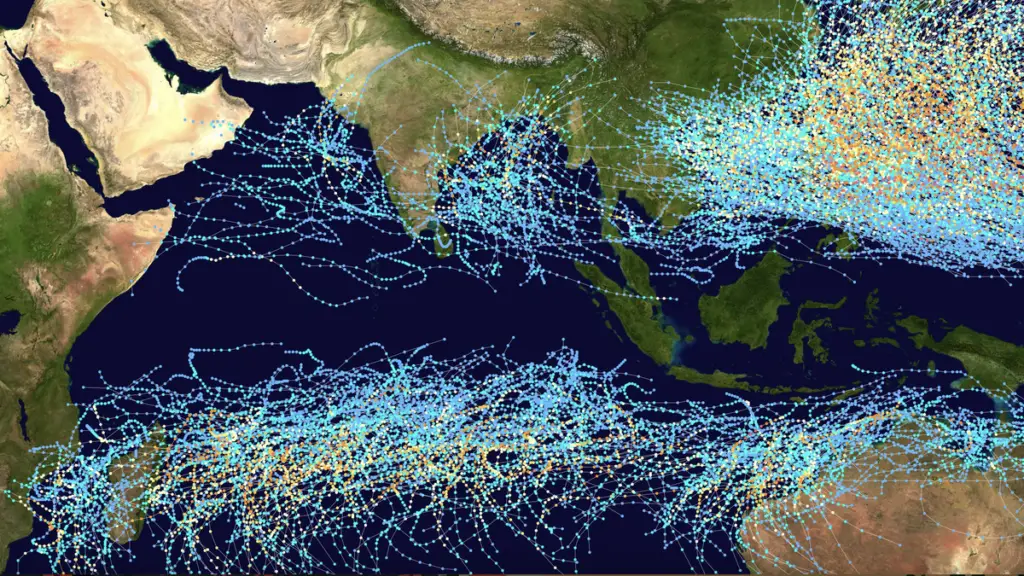Trends, Shifts or Decadal Cycles: Understanding Climate Variability in the Indian Subcontinent
A visualisation of all tropical cyclone tracks over South and Southeast Asia that formed in 1985-2005, in six-hour intervals. The colour scheme denotes wind intensities on the Saffir-Simpson scale. Storms remnants are not shown. | Photo Credit: Nilfanion/NASA, Public domain
Climate scientists have conducted numerous studies on various climate variables over the Indian subcontinent, and the results have revealed several interesting findings. One of these findings is a decreasing trend in monsoon rainfall that has been observed for over six decades. Additionally, there has been an intensifying trend in extreme rainfall events, droughts, heatwaves, and cyclones. While the period over which these trends have been estimated varies, global warming has always been considered as the primary suspect.
However, amidst all the focus on trends, there is an important question that has not received the attention it deserves: Are these changes truly trends, or are they shifts or decadal cycles? A shift refers to a sudden jump from one state to another, such as a rapid transition from one amount of rainfall to another. Seasonal monsoon rainfall serves as the perfect example of a shift, as it tends to remain above the long-period average (LPA) for about 20 years and then shifts to a state of lower rainfall than the LPA for a similar duration. Understanding whether the observed changes are trends, shifts, or decadal cycles is crucial as it has significant implications for resource planning, including water, crops, and energy.
One term commonly used by climate scientists is “anthropogenic trend”. The term “trend” implies that there are climate variables moving in a specific direction, such as the continuous increase in temperature. The addition of the word “anthropogenic” indicates that these trends are occurring within human lifetimes. However, the duration over which a variable needs to evolve to be considered a “trend” is not always clear. Climate scientists also use the term “secular trend”, referring to a variable that has been increasing or decreasing for a certain period within a longer span, such as a 30-year increase in a 100-year period.
Another term frequently used is “decadal variability”, which is not entirely distinct from a shift. Decadal variability refers to an oscillation from a positive to a negative phase over a span of tens of years. On the other hand, a shift can either mean an irreversible jump or a rapid transition that will later return to a previous state. When observing a specific variable, climate scientists often struggle to determine which descriptor best describes its observed behavior due to the lack of long-term data.
In the context of cyclones, it is crucial to ascertain whether they are becoming more common or intense, whether they are part of a decadal oscillation, or if their numbers have shifted to a new state. A recently published study in the journal Climate and Atmospheric Science has shed light on a significant change in the potential for cyclones to form over the Arabian Sea during the late 1990s. Cyclogenesis, which is the indicator of cyclone formation potential, depends on parameters such as sea surface temperature, ocean heat content, changes in winds, and rotation of winds. All these factors, except for wind rotation, have seemed to favor a higher cyclone formation potential since the 1990s. The key question is why this switch occurred so rapidly.
The study suggests that the rapid increase in the cyclogenesis potential over the Arabian Sea coincides with a shift in the ‘Warm Arctic, Cold Eurasian’ (WACE) pattern. The WACE pattern is characterized by warm surface temperatures over the Arctic and a large blob of cold surface temperatures over Eurasia. This pattern is associated with changes in upper-level circulation that extend into the Indian Ocean sector. Interestingly, global warming also experienced a slowdown around the same time, and there is evidence to suggest that a regime shift occurred during this period. Similar shifts have been observed in the mid-1970s, highlighting the occurrence of these cyclical patterns.
The causes of such changes are not fully understood, but they raise important questions for India. Regardless of whether these changes are shifts or decadal cycles, it is crucial to determine whether the decrease in monsoon intensity, increase in extreme rainfall, and the prevalence of heatwaves are long-term trends or part of processes that will eventually revert back to more favorable conditions. Planning resources for adapting to future climate risks is a complex challenge, especially considering the uncertainties in climate risk at the regional level, including sea-level rise, heavy rain, drought, heatwaves, and cyclones. With limited financial resources, climate scientists face the task of better understanding the natural variability in our own neighborhood, as this variability is also influenced by global warming.
As the new study indicates, a monsoon decadal cycle that used to last for around 20 years may now last even longer. The reasons behind this change remain unclear. It is crucial to continue studying and analyzing these natural cycles and trends to make informed decisions regarding resource allocation and adaptation to climate risks. By focusing on understanding the natural variability in our own surroundings, we can better prepare for future changes and challenges. The work of climate scientists plays a vital role in helping societies adapt to the impacts of climate change and build a more sustainable future.

